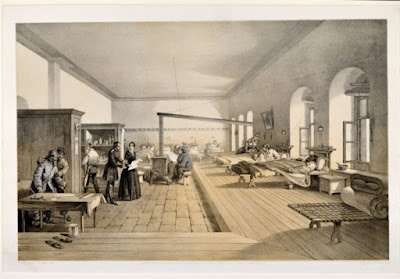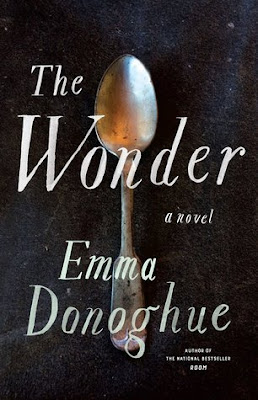The Wonder by Emma Donoghue is the tale of nurse Lib Wright, who learned her business under the tutelage of Florence Nightingale. She's sent to Ireland to watch a girl who has not eaten in months, but has become cause celebre among the Catholics. We're thrown into small town life with an intriguing mystery. Is this a hoax? A miracle? A waste of Lib's time?
At school Lib and her sister had always been hungry. (It was the time the two of them had got along best, she remembered; the fellow feeling of prisoners, she supposed now.) A sparing diet was considered beneficial for girls in particular because it kept the digestion in trim and built character. Lib didn't believe she lacked self-control, but she found hunger pointlessly distracting; it made one think of nothing but food. So in adult life she never skipped a meal if she could help it. (page 71)
Ha. I always think it's interesting to read fictional portrayals of hunger as romanticized and I like to see Donoghue pushing back against that.
Adults could be barefaced liars too, of course, and about no subject so much as their own bodies. In Lib's experience, those who wouldn't cheat a shopkeeper by a farthing would lie about how much brandy they drank or whose room they'd entered and what they'd done there. Girls bursting out of their stays denied their condition till the pangs gripped them. Husbands swore blind that their wives' smashed faces were none of their doing. Everybody was a repository of secrets. (page 94)
You really don't know what's going on in someone else's life, do you?
"Journalistic investigations must be narrow," he told her with a shrug. "Divide a reader's concern among many deserving objects, and there'll be too little left to make him shed a tear for any one."
She nodded. "Nurses are the same. It seems to come naturally, to care more about the individual than the crowd." (page 134)
This is how it has to be. Large numbers are a statistic, one person is a story.
A nurse she'd known at Scutar had passed some time on a plantation in Mississippi and said the most dreadful thing was how quickly one stopped noticing the collars and chains. One could grow used to anything. (page 152)
Isn't that the truth?
"Sometimes, when disaster strikes, there's nothing to be done but begin all over again." (page 155)
Recovering from loss is so hard, but sometimes it just has to be done.
Things I Looked Up:
jaunty car (page 5): A light two-wheeled carriage for a single horse, with a seat in front for the driver and seats for two to four persons placed back to back, with footboards projecting over the wheels. Used frequently in Ireland, including today in some tourism contexts.
 |
| Irish jaunting car. |
macadamised road (page 5): Macadam is a type of road construction in which single-size crushed stone layers are placed in shallow lifts and compacted thoroughly.
Athlone (page 5): A town on the border of County Roscommon and County Westmeath, Ireland. It is located on the River Shannon near the southern shore of Lough Ree.
Scutari (page 5): Converted military hospital in the Crimean War where Florence Nightingale and her party of nurses earned fame.
 |
| Lithograph from a drawing by William Simpson 'A Ward in the Hospital at Scutari." Florence Nightingale Museum Collection. |
worsted jacket (page 19): A jacket made of worsted, a high-quality wool.
thaumatrope (page 76): An optical toy that was popular in the 19th century. A disk with a picture on each side is attached to two pieces of string. When the strings are twirled quickly between the fingers the two pictures appear to blend into one. Here's a video with a bird on one side and a cage on the other and when you twirl it, it makes it seem like the bird is in the cage.
All the Year Round (page 73): This is the periodical that Charles Dickens first published A Tale of Two Cities in 31 weekly instalments from April 1850 until November 1850.
Adam Bede (page 80); First novel published by Mary Ann Evans (George Eliot). Published in 1850, it is the story of a love triangle and child murder. Sounds bleak.
bittern (page 86): A type of bird.
The Garden of the Soul (page 105): I can't find this on a cursory search, but I assume it's a Victorian novel.
boreen (page 105): A narrow country road, primarily used in Irish.
raree-show (page 111): A from of entertainment, especially one carried in a box, such as a peep show.
foot slane (page 122): An implement used to cut turf.

This sounds good! I like books with a mystery, and the setting sounds fascinating.
ReplyDelete